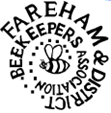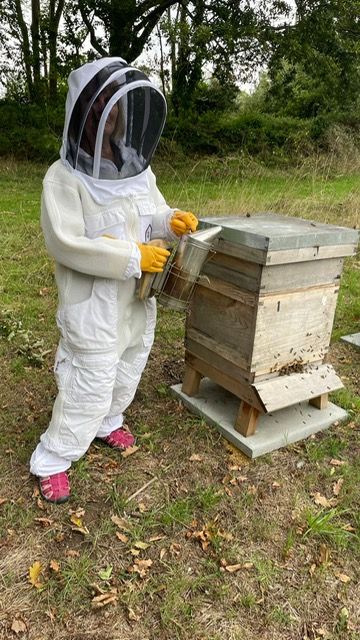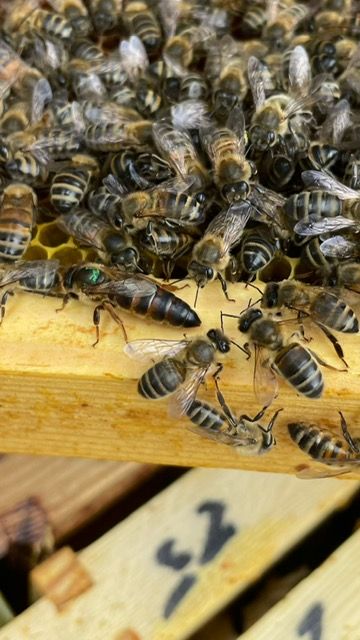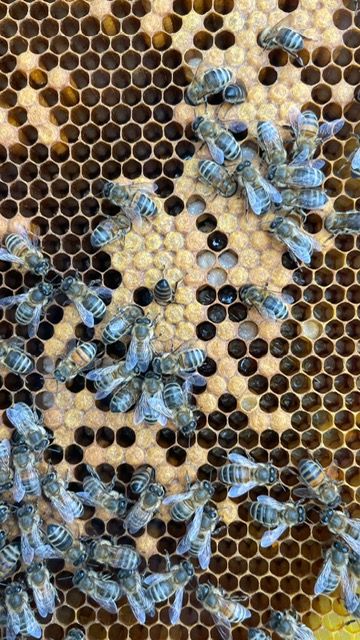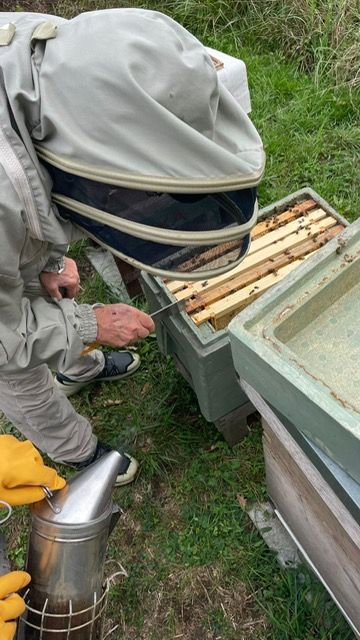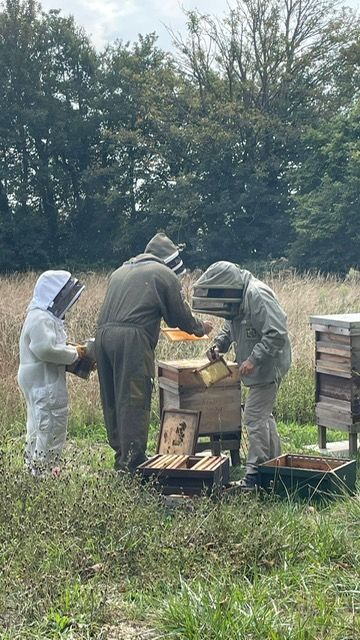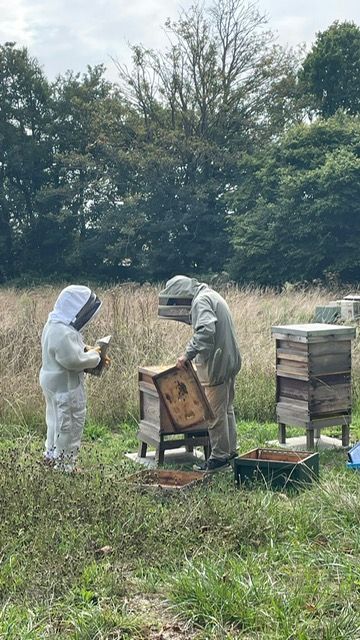Education Officer, Alan Baxter, has set up a superb teaching apiary in a private field located down a small track off Titchfield Road between Titchfield and Stubbington (PO14 3EU / ///waltzed.thundered.truck).
There are up to 10 colonies in various stages of development, plus a selection of Nucs. It is fully facilitated with ample parking, a shed, tables, chairs and a gazebo for the spring and summer months.
A colony donated to the Association by a former member is also housed at the apiary.
A series of events, workshops and teaching sessions is scheduled during the beekeeping season including:
- BBKA Basic Assessment
- Honey Bee Health Certificate Preparation
- Mentoring for New Beekeepers
- Catching and Dealing with Swarms
- Queen Rearing Made Simple
- Making up nucs
- Introducing new queens
- Uniting colonies
- Swarm Prevention and Control
- How to do a Health Inspection
- Varroa monitoring and treatment
- Recognising and Dealing with Problems such as drone laying queens and laying workers
- Winter preparation and how to avoid winter losses
Many of the above are part of the routine weekly inspections and manipulations which are open to members & prospective members to watch and practice themselves.
Information about forthcoming teaching sessions will be published weekly here, on the FDBKA Events page and on the FDBKA Facebook group. A dedicated WhatsApp Group can also be joined by contacting Alan via EMAIL.
Latest News:
The scheduled sessions have now finished for this season, though there will be some on-going weather dependent winter maintenance work. Alan will also be applying oxalic-acid treatment for varroa before Xmas which members are welcome to watch; advertised through the usual channels.
19-10-25
A very enjoyable lunch with members of our group and their partners. Thank you for your support this season and for the helpful feedback on the year’s events and suggestions for the future. Looking forward to an exciting programme next year.
Alan.
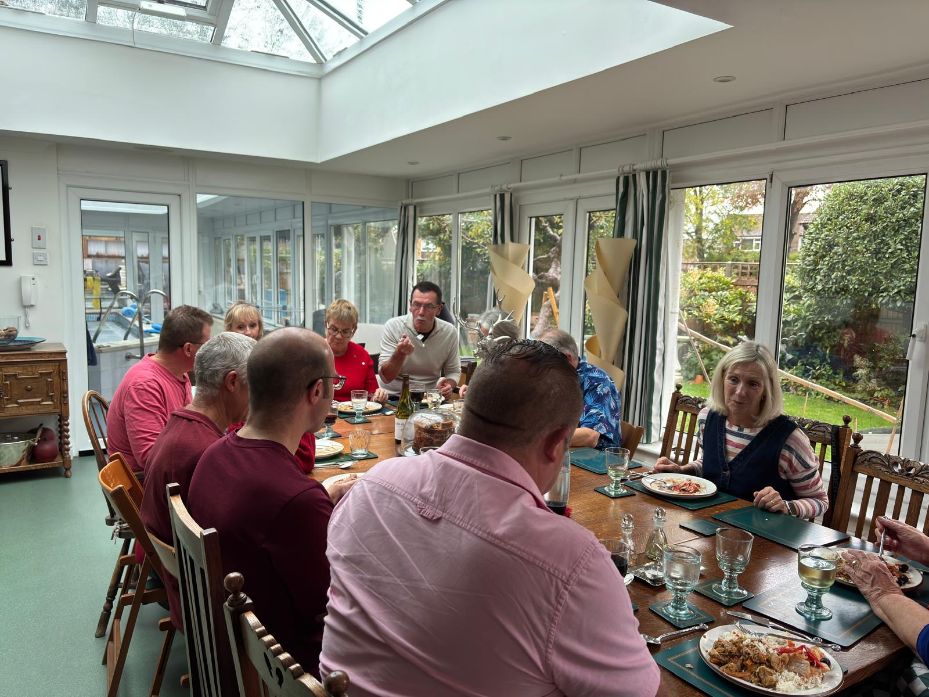
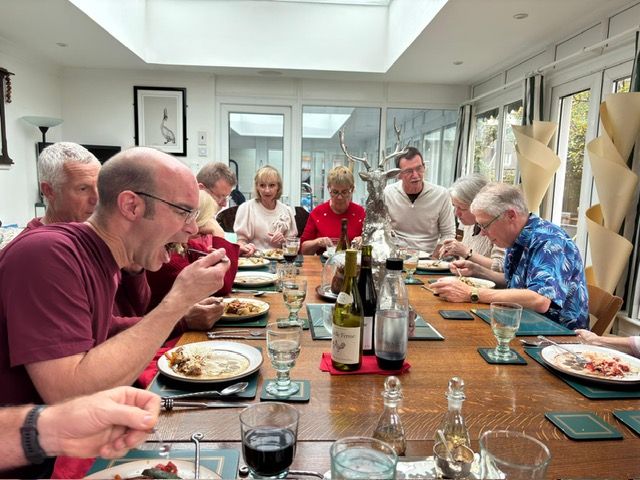
13-09-25
W we treated selected colonies with the first of a series of Oxalic Acid treatments. OA doesn’t penetrate brood cells where the varroa breed but it gets the varroa living on the adult bees. A series of treatments at 4 day intervals will kill the varroa emerging with the new adult bees until a full brood cycle is complete. This is only to reduce the level of infestation, not to eliminate varroa altogether. Monitoring is still required during and after this process.
We topped up the feeders with thin sugar syrup to stimulate the production of winter bees.
Finally we merged two weaker colonies with stronger ones and removed the queen from the colony that we suspected of having irritating followers.
Thank you to Kathy, Tim and JJ for their help.
07-09-25
A very good day with Steve and newcomers Jo and Grace who came along to see what beekeeping is all about. We continued to assess for colony strength and stores going into winter, put on English feeders with light syrup to stimulate queens to lay winter bees. There’s plenty of robbing activity and we didn’t do the merges that we had planned to avoid adding more stressors to colonies fighting to defend their stores. Next job is to finish merges, carry out varroa treatment of the colonies with a varroa count >2% and continue monitoring the hives we don’t treat. Bees are bringing in pollen and nectar and will soon be foraging on early flowering Fatsia, Ivy and Fatshedera.
“Thank you so much Alan for the most wonderful and insightful time spent today”, Grace.
02-09-25
Inspection checks for varroa and treatment completed for all colonies.
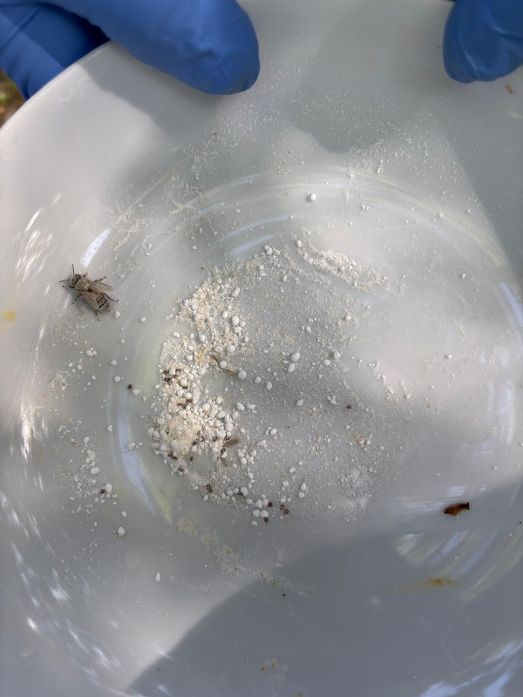
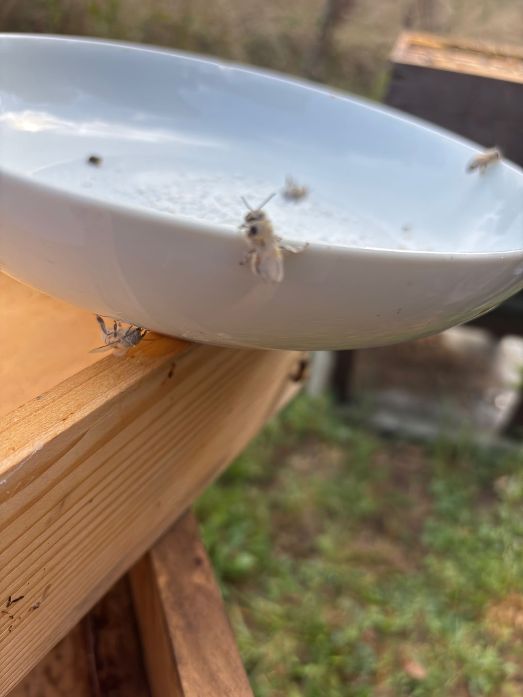
24-08-25
Winter preparations are on-going and include varroa monitoring and treatment, checking stores and feeding where needed and merging weaker colonies.
10-08-25
Today we did more varroa resistance testing. Here we’re applying wax strips to uncap a section of sealed brood. We’ll go back in 24 hours to see how many cells have been cleaned out by the house bees. If it’s 100% and the colony has a low varroa count we’ll note it for breeding from next year.
We also tested colonies for varroa load, this time by the sugar roll method. The results were very promising with a load of 2% maximum. We also uncapped a section of drone brood at the pinkeye stage but found no mites on the drone pupae.
One of our nucs was struggling so we took away the queen for dissection and gave her frames of brood to boost another nuc.
The merger we did last week is complete and the feisty bees are now much calmer.
Two other colonies are still rather small and are noted for possible merging at the next inspection.
There are still a lot of wasps around but our strong colonies are dealing with them effectively. Other colonies and nucs have their entrances closed right down to one beespace to make them easier to defend.
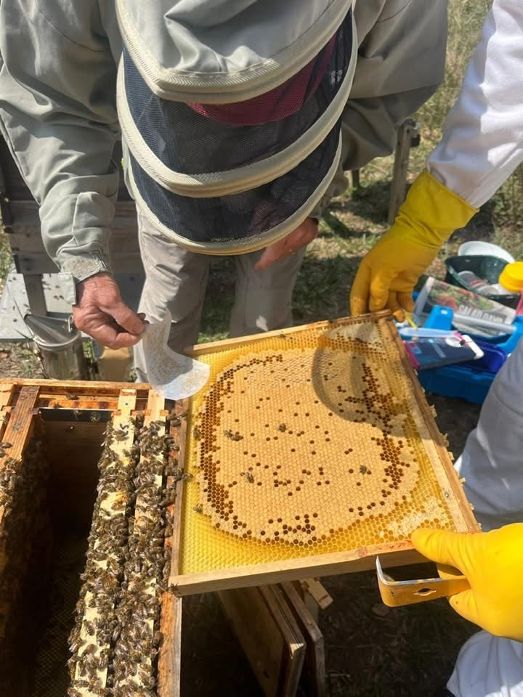
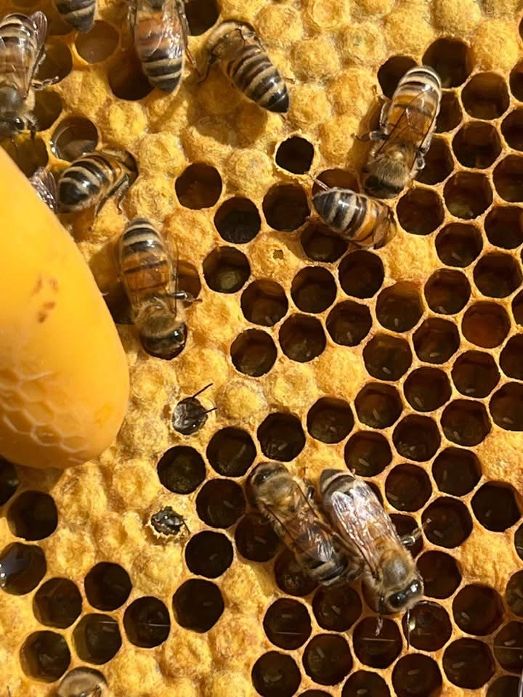
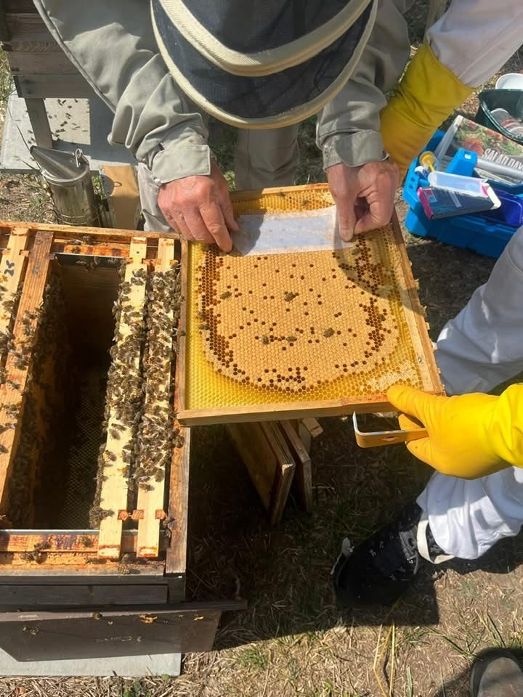
02-08-25
Thank you everyone who joined me at the apiary today. We didn’t get all the hives done but the ones we inspected and varroa tested were good. After most of you left Steve and I united colony 5 with colony 7, Steve found the queen very quickly and she’s now in preserving fluid ready to be dissected. The worker bee sample we took will be tested for nosema during the week. Our neighbour Mary came along and looked at some bees and might be a beekeeper herself one day.
“Thanks for today Alan, I really enjoyed it”, JJ.
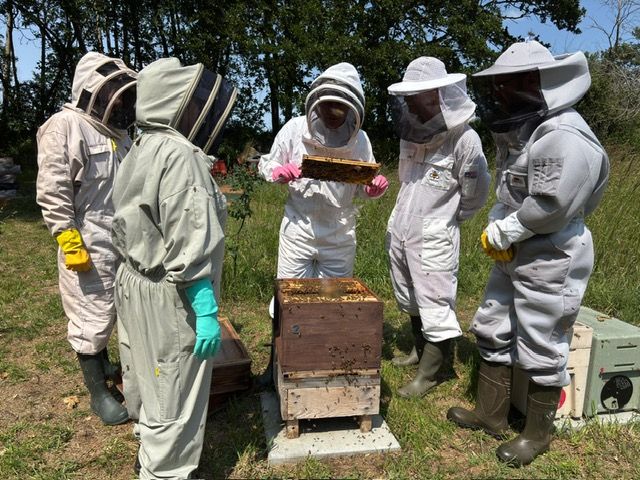
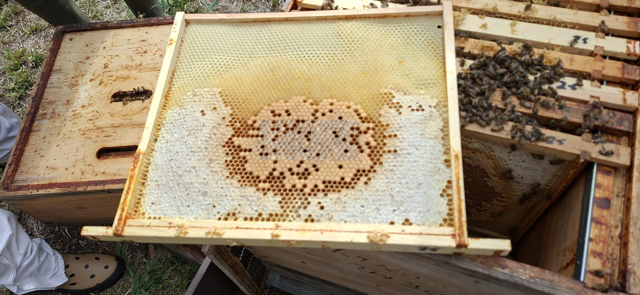
We’ve started our winter preparations at the Teaching Apiary. Here we are using cosmetic wax strips to uncap cells and test for Varroa Sensitive Hygienic Behaviour (VSH), doing varroa counts with CO2 as well as assessing colonies for strength and earmarking weaker ones for merging with others. We found and removed the queen from a troublesome colony and united it with a gentle one as part of our zero tolerance policy for badly behaved bees. We removed all the drone brood to stop them passing on bad genes to other people’s new queens All the hives will be left with at least one full super and 6 frames of stores in the brood boxes. Next job is to treat for varroa all the colonies that have a load of >2% and who fail the VSH test.
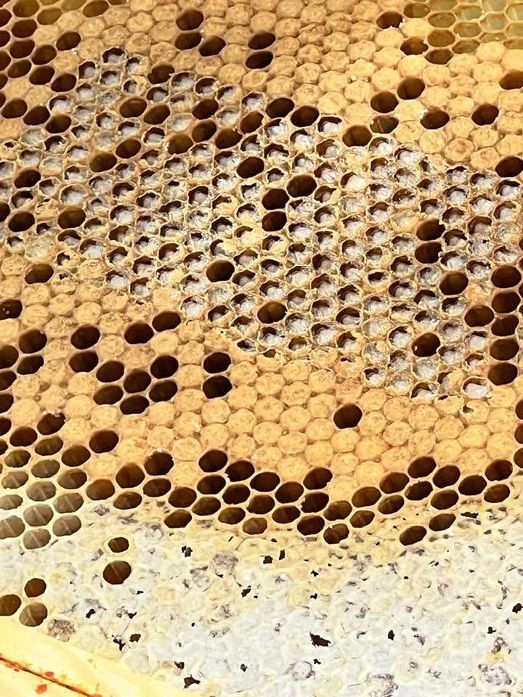
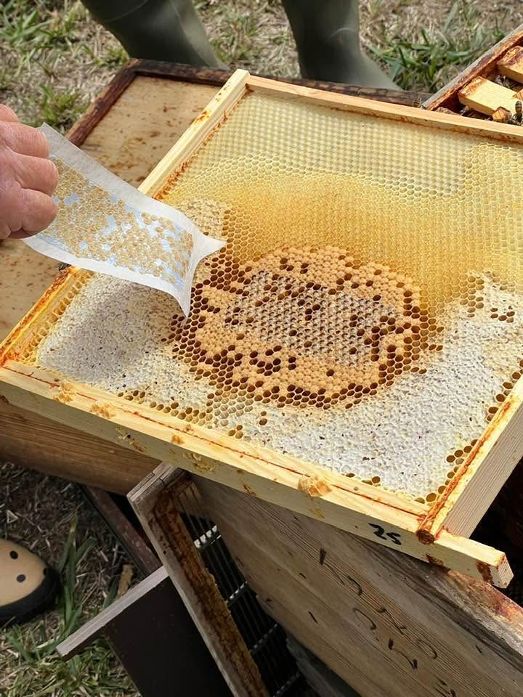
21-07-25
Two colonies that were tested had less than 2% varroa infestation. If a repeat test next week is the same they might not need varroa treatment next month.
One of these colonies is very gentle and will be used for breeding queens next year. The aim, in a few more seasons, is to be completely treatment free, but only careful monitoring and selective breeding will achieve that.
“Thank you Alan for a very interesting and informative session today doing varroa checks and searching for queens”, Claire.

13-07-25
Queen Rearing at Laylands today. The photo shows JJ trying his hand at grafting larvae.
“Thanks Alan, for your excellent talk on Queen Rearing, it was very informative and I learnt so much”, Phil.
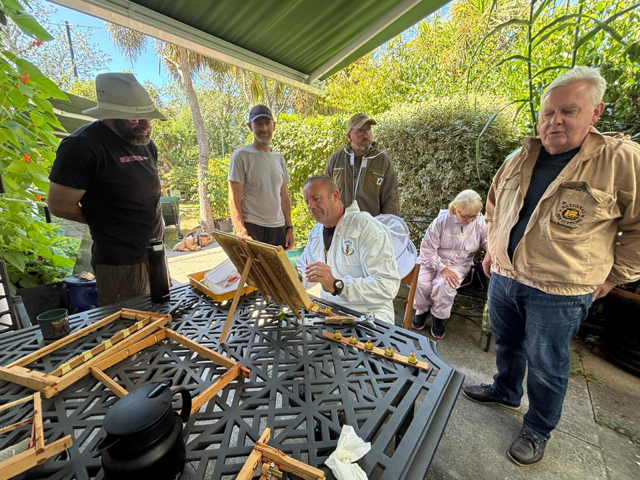
29-06-25
Good day today extracting and bottling honey. Thank you everyone for your help and to Penny for a delicious home cooked lunch à la Française.
“A very interesting day and thank you and Penny for hosting us”, Kevin.

28-06-25
This evening we put on clearer boards for tomorrow’s extractions and checked the Apidea being united with colony no RV7. We saw the queen, eggs and larvae still in the Apidea despite the bees having chewed through the newspaper. She will soon run out of space to lay in the Apidea and will move down into the brood box. We then checked some supers and found 2 new virgin queens. One Nuc has failed to produce a queen but will be useful as a starter colony for the next batch of grafts. Looking forward to extracting the honey tomorrow and to jarring and labelled honey from the last extraction.
26-06-25
Uniting an Apidea mini mating Nuc with a queenless colony using the newspaper method. Extra room is provided by a National brood box acting as an Eke.
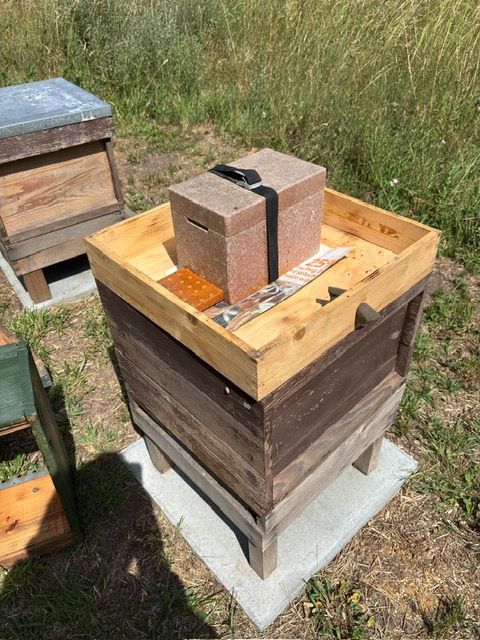
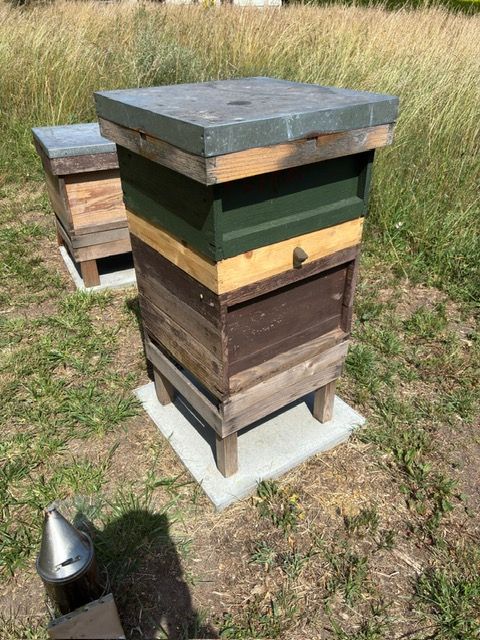
25-06-25
Huge congratulations to all six of our members who took their Basic Assessments last Sunday. They all passed. Our members who have shown their mettle are: Andrew, Frances, Kieran, Martin, Pete and Scott. We are all enormously proud of them and hope that they’ll help with the teaching of other members.
22-06-25
Well done to all six candidates who took the Basic Assessment at the Teaching Apiary today. Hopefully everyone enjoyed the experience and are happy with their performance.
The results are expected to be available within one week.
“Thanks for arranging all the prep, Alan”, Kieran.
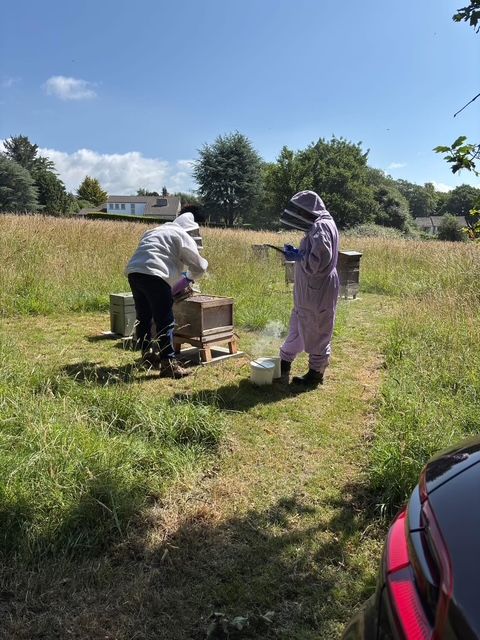
19-06-25
Update on the splits that we did together:
3 of the Nucs have produced laying queens and have been moved into full brood boxes. 1 has a virgin queen that was briefly seen today and is waiting to be mated. The double chamber nuc is too soon to disturb. One remaining Nuc still hasn’t any brood but I’m not worried about it yet.
The treatment of the aggressive colony that we killed the queen and split up and merged with two other colonies has been completely successful..
15-06-25
No teaching sessions this week as Alan is supporting the HBA Queen Rearing course.
08-06-25
Mock Basic Assessments and syllabus revision with Tim as the Assessor. Everyone ‘passed’ today so looking good for the real thing on the 22nd.
“Many thanks Tim, you gave some very good info today”, Tina

The other group did some inspections and swarm controls by splitting a colony into a double-sided Nuc. The parent colony is on brood and a half so we separated the two halves with a super and a queen excluder and left the upper half with an open charged queen cell. The aim is to experiment with a two-queen colony, a classic way of increasing honey production but not often seen nowadays. Alan will go back once the queen cell is capped and remove the super between the two brood boxes leaving just the queen excluder. Alan confesses to making this up as he goes along so the results will be interesting!
Finally we did a CO2 varroa count which produced one mite from a sample of about 300 bees which is good.
Robbing is still going on so we hope for warm sunshine to help the bramble to produce nectar.
01-06-25
Today we cleared some Supers using different methods including Canadian and Rhombus clearer bords and a fume board sprayed with BeeQuick. The Supers were replaced with brood boxes of foundation for the bees to draw out beautiful fresh frames of comb. The Supers were put into insect proof Ikea zipper bags for transporting back to the honey room. There we de-capped and extracted 30 kg of honey and tested it for moisture content with a refractometer. The honey will stay in a settling tank for 24 hours before being skimmed ready for decanting into storage buckets or straight into jars. We talked about the honey regulations concerning content and labelling, key temperatures and conditioning the honey to delay crystallisation and increase shelf life.
“Alan, thoroughly enjoyed the session today, thank you”, Kevin
“Thanks again for your wisdom and knowledge, I’m really enjoying my beekeeping journey”, JJ


25-05-25
A very windy day to inspect bees but there was a long session of routine tasks with lots achieved including finding 3 new queens, learning how to pick up a queen, CO2 testing for varroa, dealing with a rogue colony, drone brood removal, merging two colonies, looking for early warning signs of swarming, cutting out queen cells for incubation and to give one to a queen less Nuc, and more……
“Thank you Alan for another great informative day”, Claire
“Thank you Alan, informative as always”, Rick
“That was a really interesting day”, Jeri
“Absolutely fabulous day”, Neal
18-05-25
12 people attended today. The first part of the day was part 4 of the Basic Assessment preparation, learning about pests and diseases, apiary hygiene and comb change, recognising healthy bees and brood and what to look for when things aren’t well. Then some varroa monitoring and swarm prevention using comb management techniques, and simple queen rearing by making another split into a Nuc. The earlier splits were checked and queen cells broken down leaving one uncapped, charged one. The stroppy colony is now much calmer after the culling of the queen and separation into two smaller units, one of which has been united with a calm colony. The other one is also much calmer. It is now hopelessly queenless and waiting to receive a new queen from this year’s batch currently in Apidea mini mating Nucs.
“Thanks Alan, I really enjoyed myself & looking forward to the next session”, Robert
11-05-25
Another excellent day across the two sessions. The morning session saw 16 attendees split into two groups headed by Greg Young & Alan Baxter.
Also attending was Penny Melville-Brown skilfully making a skep from thatching straw.
The afternoon session was part 3 of preparation for the BBKA Basic Assessment.
Highlights of the day included:
- Sugar roll testing the varroa resistance experiment colony and observing its hygienic behaviour test,
- Learning about varroa, how it lives and breeds, and the dangers it poses for bees,
- Making a split into a nuc with the queen and what to do if you cannot find the queen,
- Finding and culling the queen in a misbehaving colony prior to requeening frommore gentile stock,
- Learning about swarming behaviour, the causes of swarming, understanding the “swarm triangle” and its importancein swarm prevention and swarm control,
- Collecting and giving swarms,
- How to merge two colonies,
- How to introduce a new queen to a colony
- Testing for queenlessness, how to recognise drone laying queens and laying workers,
- Introduction to pests and diseases with AFB, EFB, Sacbrood and Chalkbrood.
One unusual sighting today as seen by the arrow on the above photo is a white-eyed drone. The small eyes on the front of the head called ocelli have a white pigmentation probably caused by a recessive gene. Quite a rare sight but nothing to worry about.
“Fab day! Thank you”, Neal
09-05-25
Testing as area of brood for Varroa Sensitive Hygienic (VSH) behaviour in the donated colony that has not been treated for 5 years. If the bees clear out all the dead larvae quickly it’s a good sign that they have developed some resistance to the parasite.

04-05-25
Unfortunately todays session was cancelled as Alan has the dreaded lurgy! Hopefully he will have recovered in time for next weeks sessions.
29-04-25
The morning session consisted of doing a split on a colony showing the first signs of swarm preparation. We could not find the queen so we separated the flying bees from the queen, brood and nurse bees thereby breaking the “swarm triangle”. The Nuc contains a frame of egg sand very young larvae with some nurse bees to look after them, all the flying bees will return to the Nuc and it will make its own queen. The parent colony is on another stand away from the Nuc. These are good natured bees worth breeding from.

The afternoon session, for those that could not attend in the morning, was also a split for a colony readying for swarming. It was good to see the Portsmouth BKA Education Officer attend too.
“Thank you Alan for another great visit to the Teaching Apiary filling us with your great bee knowledge“, Claire.
28-04-25
I’ve always been sceptical about the 3 yards / 3 miles rule. Here’s a colony that was brought from my home apiary less than a mile away and “promoted” to a full brood box. It has settled in beautifully with no attempt to go back. I’ve done this many times in the past few years and never hd a problem. Though, if it comes to an exam ….go by the book!
Alan
27-04-25
Great day in the sunshine at the apiary learning about swarms, finding and marking queens, working with the gentlest of bees and much more……
“Was a great couple of hours“, Matt.
13-04-25

Excellent turnout at the Teaching Apiary today for all 3 sessions despite the threat of rain. We found lots to learn in the colonies we inspected, including finding a drone laying queen which we culled: after an hour to let them know they were queenless, we gave the colony a frame of eggs and young larvae. These came from the colony we shook swarmed 2 weeks ago and is now roaring away on new clean comb.
“A great learning opportunity“, Martin.
02-04-25
The Shook Swarm Colony is busy drawing out comb. The queen was seen but we didn’t spend much time inspecting due to the very cold wind so no eggs seen. Alan will treat them with Oxilic Acid before any brood is capped to get rid of varroa. There are more nurse bees than foragers so a sachet of Candipollen was added to give the bees a protein boost.
The colony was calm and good tempered and a pleasure to work with.
30-03-25
The colony donated to the association was Shook Swarmed due to all the frames being rotten, fragile and not fit for purpose.
The adjacent video shows the colony the following day enjoying the morning sunshine.
The exercise was completed by putting in the entrance reducer and feeding to assist the bees with drawing out foundation.
